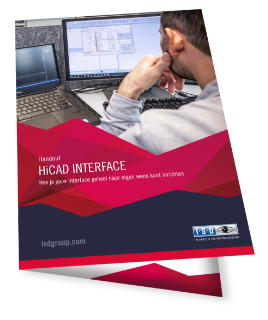
Step by step, De Boer Machines Netherlands is working towards an organisation full of smart automation. "Smooth logistics and design-driven data are central to this," says Head of IT Peter Nas. HiCAD, ISD's CAD software, plays a key role in this. "Automation was all about saving time and preventing errors by making processes easier and more transparent."
The list of automation steps De Boer Machines Netherlands has now taken is impressive. The Wijchen-based company, which produces machines for the coarse-ceramic/brick industry, started taking its first improvement steps in 2010. Since then, among other things, automated item numbering has been realised and HiCAD has been linked to the RidderiQ ERP. Here, the company not only exchanges bills of materials, but also stores project and article data directly in HELiOS, ISD's PDM/PLM solution. In addition, an export plug-in was developed for the automatic generation of DXF and STEP files. These are needed for outsourcing production to suppliers. In addition, a parts list analysis tool was developed for HiCAD and a plug-in was optimised for the creation of parts books and lists. Since this year, De Boer Machines Netherlands also uses 3D designs and models for automatic milling of parts to size. In doing so, the software takes into account the measured value of the physical part.
"The overview is a sample of what we have done, among other things, but always with the same thing in mind: working more efficiently and preventing mistakes," Nas points out. "You sometimes run into something that could simply be improved. For instance, we noticed that customers regularly placed orders based on outdated documentation and old part numbers. We then started working on that, but the result was not the desired one. That led to some confusion. That is why we now only make drawings and lists available via an online portal. This prevents us from working on the basis of old data. What is online is always up to date. Our internal sales and customers look at the same info."
Automation requires thinking. This is something an entrepreneur can do himself, but in the vast majority of cases, companies knock on ISD's door. This also applies to a plug-in that De Boer Machines Nederland had developed. Nas: "When generating DXF and STEP files, we called in help. Previously, our work preparation department generated these and sent them via standard functions in the software. Only these files contained document numbers, while the logistics chain is set up on serial numbers. With ISD, we devised a script that connects to the same parts book plug-in. This automatically gives files the correct name and puts them in the correct folder, which we automatically archive. We also automatically put that folder on our network so that we can send it to our supplier."
"CAD software plays a key role in work processes," Nas states. "For design, for example, but also the logistics chain, HiCAD has become a key element. The 3D CAD software has had a positive impact on the entire chain: from production and procurement to the customer." Small automation adjustments sometimes have a big effect in this regard. "An engineer can see at a glance whether he has entered everything correctly. With long parts lists, this is sometimes difficult to see. Hence, we had a function for this created by ISD." Preventing errors is essential. "We want to prevent incorrect entries in our ERP system. The higher the quality of data in the logistics chain is, the less is the loss of time in the same chain."




